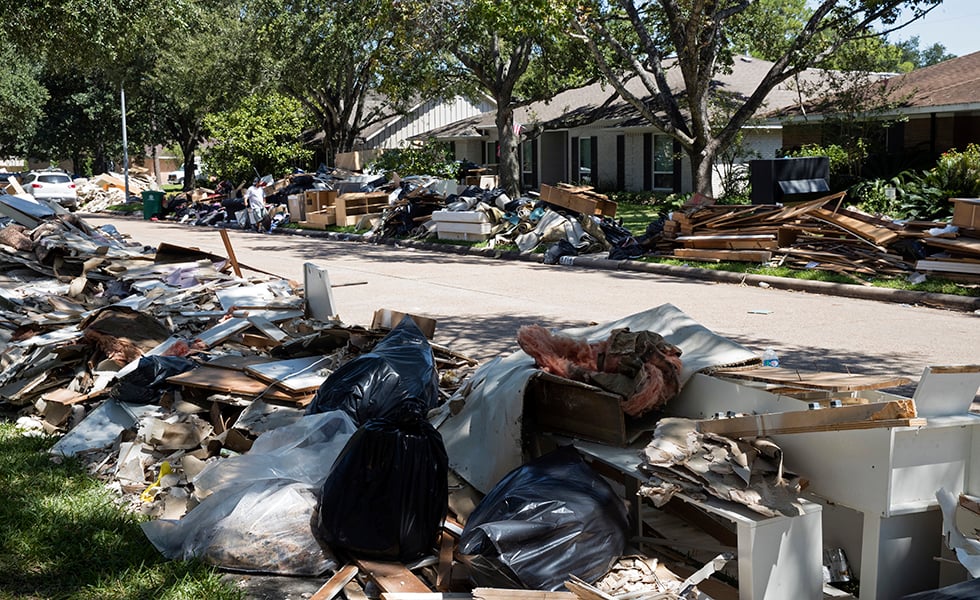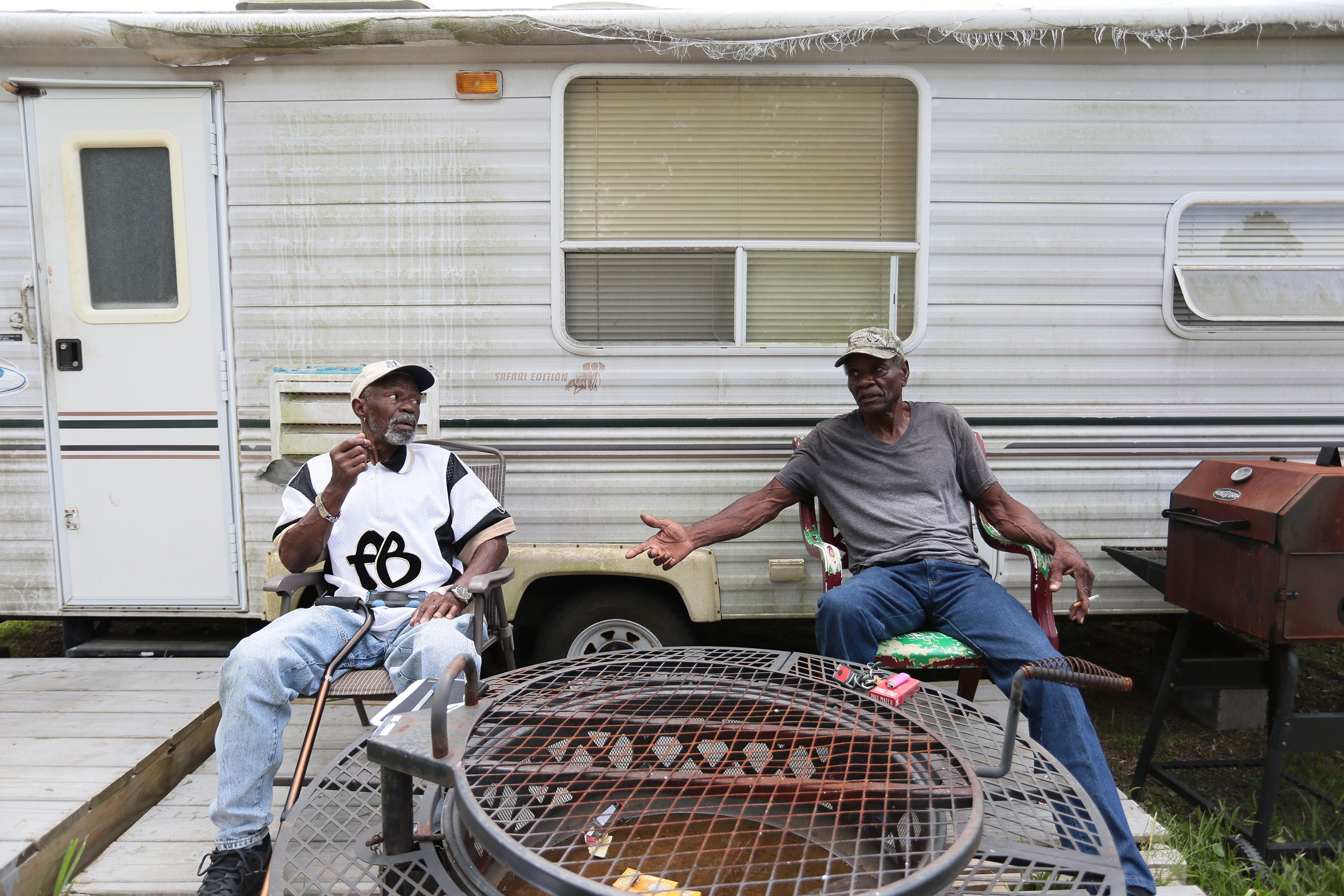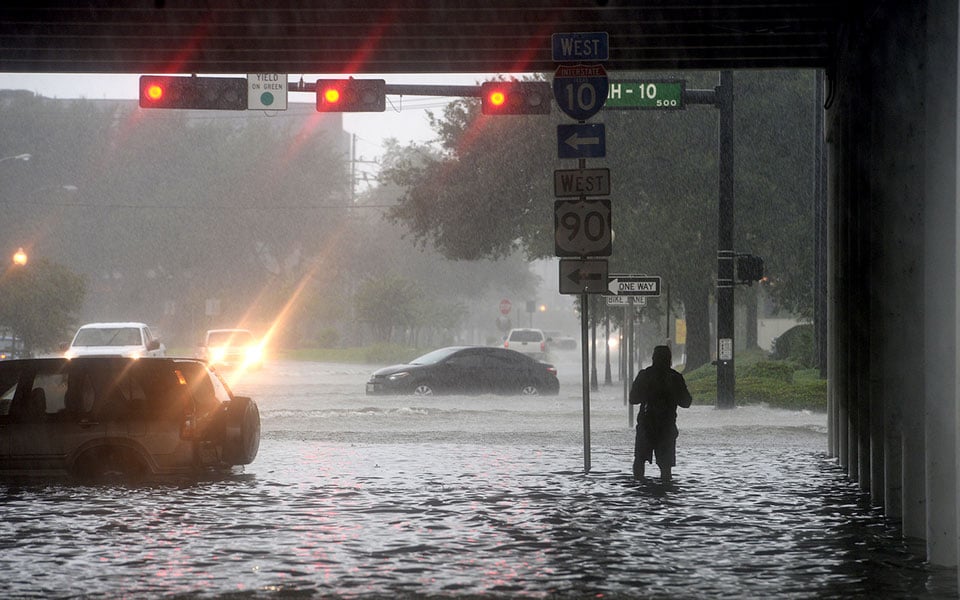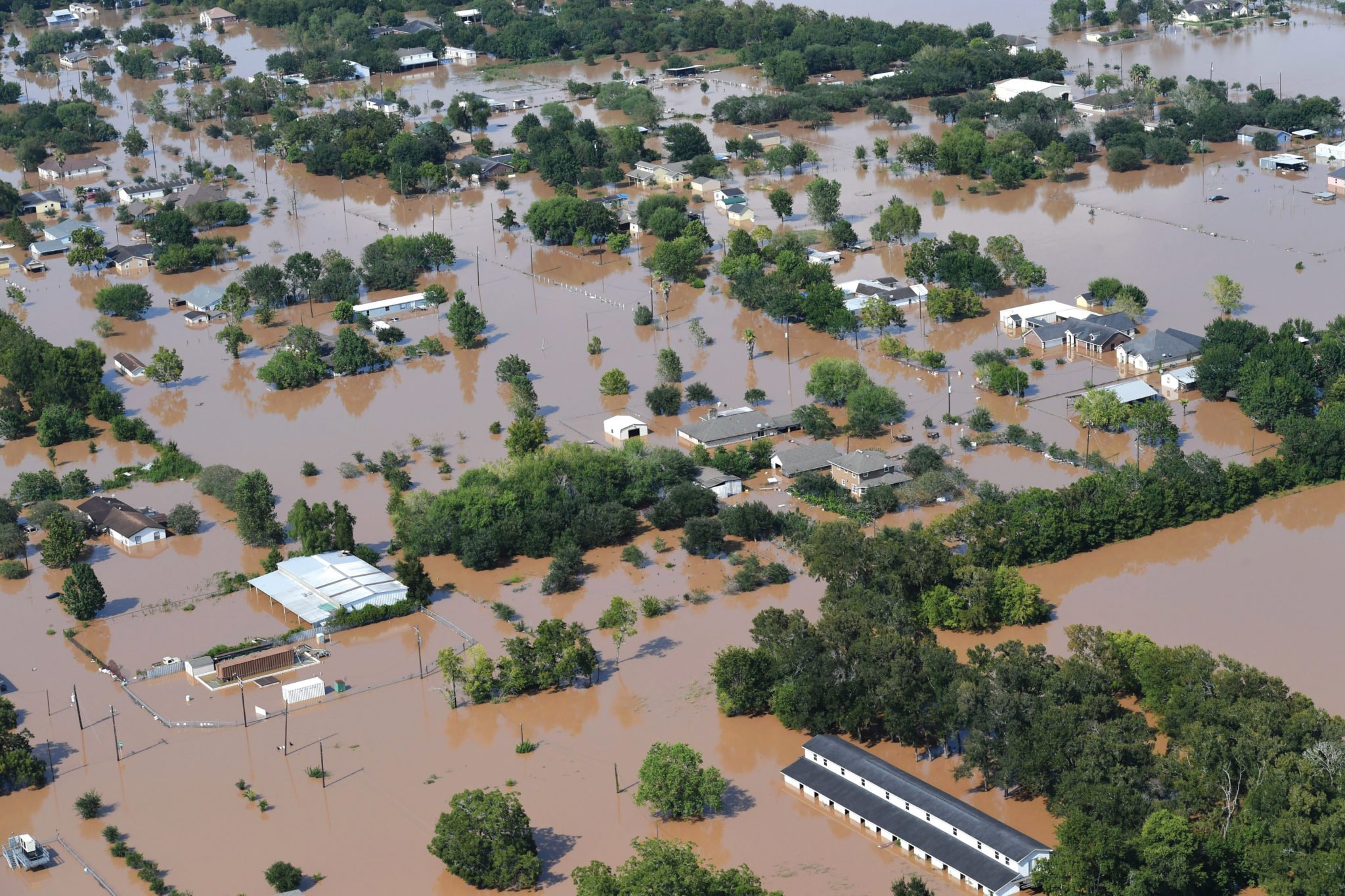
Heads in the Mud
A year after Hurricane Harvey, what has the Bayou City learned?

Above: Flooded homes in Houston after Harvey. The storm damaged more than 200,000 houses in Harris County alone.
“The people of Houston and their officials will have to decide whether they are building a great city or merely a great population.”
These words, from a 1929 city planning report (mostly ignored), were written when Houston had a population of about 300,000 people spread across approximately 70 square miles. Today nearly 7 million people live in the Houston metro, an area the size of New Jersey; the region is expected to add another 5 million people by 2050.
This is certainly a great population. Whether it’s a great city was called into question, yet again, by Hurricane Harvey, which dumped up to 50 inches of rain across a vast swath of southeastern Texas, killing 82 people and causing $125 billion in destruction, including more than 200,000 damaged homes in Harris County alone. In the immediate aftermath of the storm, Houstonians pulled together like never before, performing daring boat rescues, hosting strangers in their homes and helping their neighbors rip out soggy drywall.

But even before the water receded, signs of Houston’s congenital pathologies began to surface. On September 5, just over a week after Harvey made landfall, Leo Linbeck III, the executive chairman of Houston-based construction giant the Linbeck Group, penned an op-ed for the Houston Chronicle headlined “Hurricane Harvey was not a catastrophe,” in which he cheerfully calculated that 94 percent of Houston homes suffered no damage, only .0000075 percent of the population died and the economic damage constituted less than 20 percent of the region’s annual output.
The real danger, Linbeck insisted, wasn’t the flooding but rather a potential overreaction in the form of more planning and regulation. “There are some who are spinning a narrative that Houston’s response was a failure, and to use [sic] this ‘failure’ as a pretext for changing our formula for success,” namely, “a more sophisticated and economically efficient land use system that relies heavily on deed restrictions rather than the antiquated politically-driven, top-down, expert-driven, bureaucratic zoning system that favors entrenched interests over new entrants.”
Nor should Houston do anything to rein in the oil and gas companies responsible for global warming, Linbeck argued. “The claim that CO2 causes worse hurricanes is unproven and controversial, even to believers in climate change. Regardless, even if you believe that CO2 is causing climate change, you should be thanking the energy entrepreneurs in Houston for bringing cheap, clean natural gas to the nation.” (Experts actually say warmer sea temperatures likely increased Harvey’s potency.)
Outraged readers wrote in to complain — “This sort of attitude is why we can’t have nice things,” one commenter grumbled — but Linbeck’s what-me-worry response to Harvey set the tone for the entire recovery. Even Houston’s progressive mayor, Sylvester Turner, when asked if better city planning might have mitigated the flooding, replied that “zoning wouldn’t have changed anything. We would have been a city with zoning that flooded.”
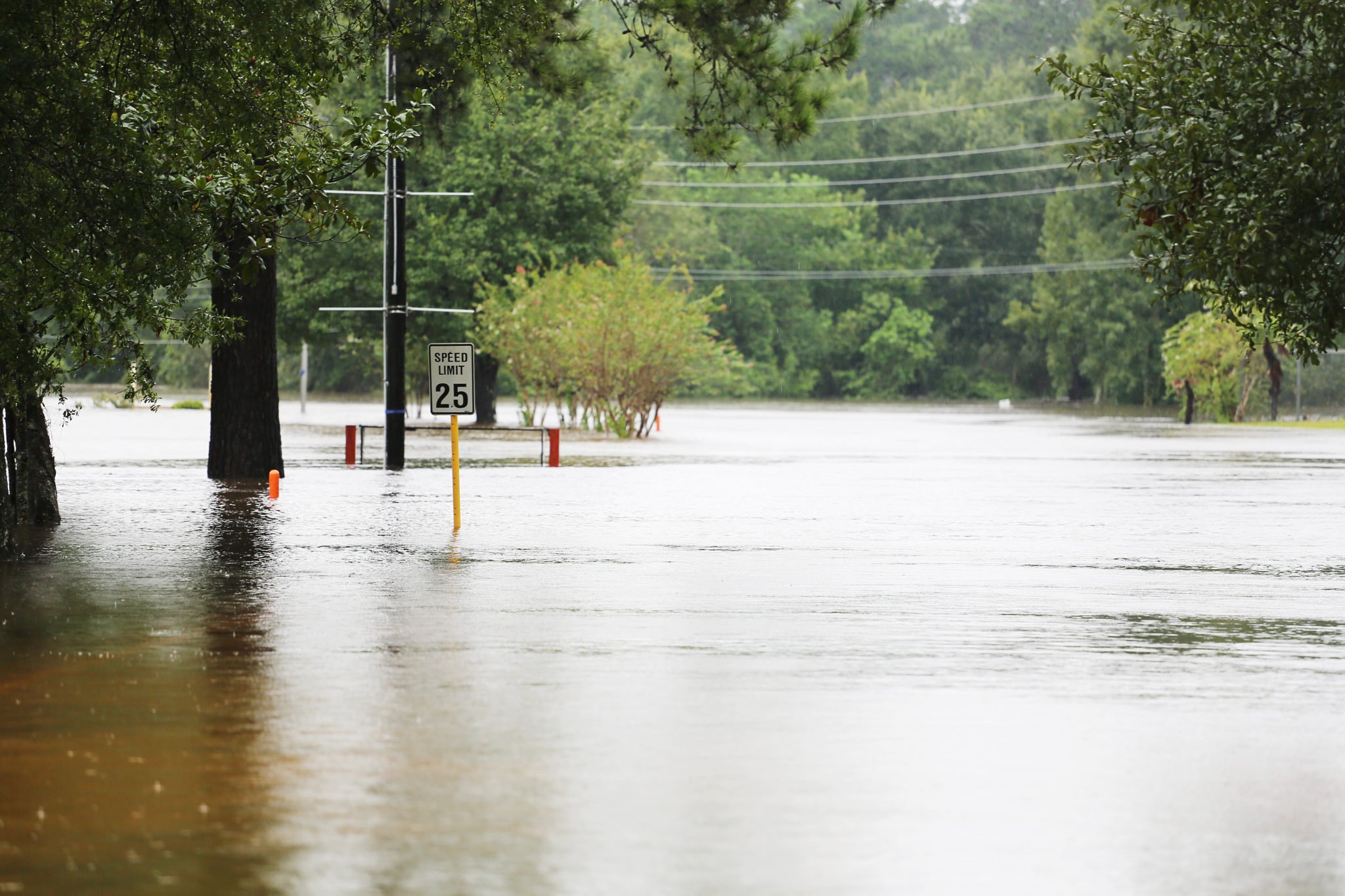
State leaders were no better. Governor Greg Abbott almost immediately ruled out tapping the state’s $10 billion Rainy Day Fund. Instead, the apostle of states’ rights went begging to the federal government, then threw a temper tantrum when Congress proved insufficiently generous. When Mayor Turner proposed an extremely modest property tax hike to help clear the streets of debris, Abbott criticized him for being a tax-and-spend liberal. Only after a Chronicle editorial compared the governor to President Gerald Ford (“Ford to City: Drop Dead”) did Abbott come to Houston and hand the mayor a check for $50 million — on the condition that Turner not raise taxes. In May, when Turner and 56 other elected officials wrote Abbott to request more funding, Abbott replied with a condescending note implying that the mayor had misspent the first $50 million.
Attempts to prepare Houston for the next big hurricane have been similarly lackadaisical. Rather than prohibit new development in the floodplain or establish a fund to buy out repeatedly flooded properties, the Houston City Council opted in April to simply require new buildings in the 500-year floodplain to be elevated 2 feet above flood level — conveniently ignoring the fact that flood maps are woefully out of date and most of the homes that flooded during Harvey were outside the floodplain. Even this incremental improvement proved controversial, passing by just two votes amid fierce opposition from real estate developers. A few weeks later, the council considered a developer’s request to build 900 homes on a former golf course in West Houston that sits inside the floodplain. The development was approved unanimously and without debate.
The one public official who seems to have taken Harvey seriously is Harris County Judge Ed Emmett, a Republican previously known for championing the construction of the Grand Parkway, Houston’s third ring road and an invitation to endless sprawl. Emmett called the hurricane a “game changer” and is now working on an ambitious overhaul of the region’s development policies. “Flood control is job one, and we’re going to do it,” he said in December after the county passed new floodplain development restrictions. He also pushed a $2.5 billion bond package that will fund a new flood warning system, channel improvements, buyouts and engineering studies. Harris County voters approved the plan on August 25.
Even before the water receded, signs of Houston’s congenital pathologies began to surface.
Emmett’s willingness to reconsider his laissez-faire planning approach was welcome, but rare. Since being founded by New York real estate speculators in 1836, Houston has largely been run by and for the real estate industry. Many of its mayors, most recently Bob Lanier (1992-1998), have been developers. The city’s chief resilience officer, aka flood czar, is Stephen Costello, whose company built several major housing developments inside the Barker Reservoir in the 1990s — all approved by the City Council, naturally — despite warnings from the Army Corps of Engineers. Thousands of these homes flooded during Harvey, and the residents are now suing Costello.
Disaster capitalism is alive and well in Houston. Harvey was an unmixed blessing for the construction industry, which continues to repair houses as fast as its largely undocumented labor force can work. As for real estate, the constricted housing supply has sent the median home price soaring to an all-time high of $290,000. Investors both small and large are snapping up flooded homes for pennies on the dollar. After all, thanks to the National Flood Insurance Program, even repeatedly flooded homes can still get government-subsidized insurance.
In short, little has changed in Houston. As long as the city remains the oil and gas capital of the country, people will continue moving here for the high-paying jobs and cheap housing. And as long as they keep coming, developers will keep building new and farther-flung subdivisions. Houstonians have been dealing with natural disasters since the flood of 1837 nearly wiped the nascent city off the map. We’re survivors. But as Hurricane Maria showed in Puerto Rico, not every community has the infrastructure or the financial resources to bear the brunt of nature’s growing wrath.
Houston has never been good at planning — we’re too busy pumping oil and making money today. As for the consequences? Après nous, le delúge.
